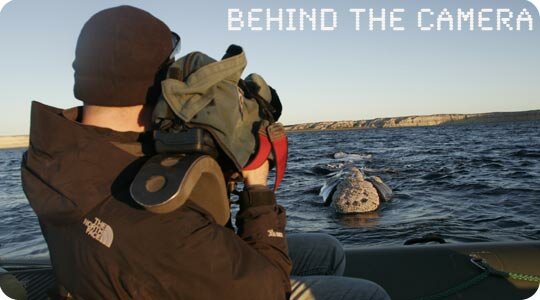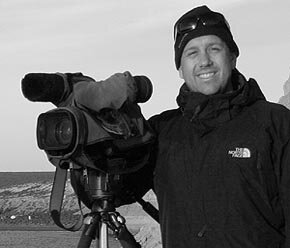A little bit of history....
Having finished the documentary, I often wonder that myself!
The most important issue, with producing wildlife and science productions, before any money is raised, before any plane tickets are booked, before any equipment is rented or purchased, and sometimes before a script is even written, is to gain access to the subject. In our case, it was gaining access to film southern right whales. Without the access to whales, we could not even begin to think about producing a film like this.
Because so many people are involved in the research, the conservation, obtaining the permits to do the research, and the administration and organization of specific geographical areas, filming whales requires the ability to create numerous partnerships. We were initially invited by an NGO, Instituto de Conservacion de Ballenas (www.icb.org.ar), to film and produce a video for a new education initiative in Argentina. They received funding from the government of the province of Chubut – it was called “Bringing Whales to Your School” ("Trayendo las ballenas a tu escuela").
With the help of ICB, we obtained the necessary permits from the provincial government to film whales within the reserve, and underwater. ICB also acted our translators and 'fixers', arranging accommodation, a rental car, additional permits and generally helped out with other administrative tasks along the way. Since we are absolutely hopeless at speaking Spanish, this partnership was crucial in making the process work.
In exchange for all of their effort, we produced a 5-minute piece about their organization with the footage shot for the documentary program, which co-wrote. We also gave ICB footage and photographs for future press releases and educational initiatives. The lesson we learned through the years is that, it is always beneficial to form good partnerships with a local NGO.
From the beginning of the project, we all agreed that the documentary would be produced in both Spanish and English, as stipulated by the grant we received to make the film – and that it would be distributed for free to students in Argentina as part of the education program they were developing, while we would host the online versions.
When documenting local issues in another country, we feel it is crucial to share experiences, especially with students. So often people do not know about the issues surrounding whales that inhabit their coastal waters. Those who come in to film too often leave little for the local community in return. This was an occurrence we often witnessed in countries we worked in on a former project - the Voyage of the Odyssey.
The Voyage of the Odyssey was our epic project. For 5 and a half years, Genevieve and I were part of a team that traveled around the world on a whale research sailboat, documenting the work, the science, the research, local issues, the nature and wildlife, all while producing environmental stories for a web series hosted by PBS – www.pbs.org/odyssey
It was very unique, in that PBS funded a program that would only be on the internet. We produced stories on the boat, called Odyssey logs, that we published via satellite directly to the PBS website.
We had incredible power to publish 'live'- when we posted a story via our laptop connected to the marine satellite setup, it was up on the servers in Washington – from anywhere on the planet. It was a unique experience to create and upload stories while being at sea surrounded by hundreds of miles of ocean and no land in sight.
This was before the popularity of blogs took off, or even podcasting. We relied on creating audio reports in Real Audio format, but found that most people just read the transcripts of the stories - sometimes educational, sometimes anecdotal and people liked seeing the photos from the day. Periodically, we would upload short video documentaries anywhere from 3-5 minutes in length to bring people along on our journey.
While finding and producing these stories for the 5 and a half-year, we always had to do it on a tiny budget, with minimal equipment - most of which we had to purchase ourselves. We learned to be very creative using 'off the shelf' tools and equipment.
In 2001, one year into the expedition, we started earthOCEAN media as a way to manage our money and be creative with tools. We purchased cameras, film, developed the film, bought a video camera, laptops and even got the software to build everything with. The boat had a couple of computers, but they were used mostly for research. So while we had great access, and a pipeline directly to PBS, that was it - that was where we learned how to produce materials on a limited budget.
Part experiment, part groundbreaking, partly insane, the site is still online, even though our last report was published when the Voyage finished in August 2005. It has since turned into a unique education resource ( believe it or not, our most popular story is on the giant squid – more about that another day! )
When the Odyssey departed in March 2000 from San Diego, we had a DV camera (Canon XL-1), a G4 Mac desktop running final cut pro (version 1) with a 80 gig hard drive, notepad (to create HTML pages – I coded everything by hand, due to PBS online production policies), and Photoshop. We had a 1 megapixel Nikon coolpix that would only work for 10 minutes at a time (due to problems with the batteries). Often, I would take 'screen shots' from the video shot with the XL1 to help with imagery for the website. As time progressed, we purchased one of the first G4 notebooks to come out, a few external 60 gig hard drives (which would only last a few months in the hot, salty conditions of the boat), an external DVD burner and a copy of DVD studio pro version 1.
For the documentary, Southern Right Whales of Argentina, we applied a similar model. We would film with digital cameras, edit on a faster G4 notebook computer, an external hard drive (this time holding 500 gig), but bring lights, an underwater housing, and a few important audio tools for interviews.
Most important, we would bring two video cameras – one for only filming underwater (Sony HDV Z1), which we already owned, and another for filming interviews, and the majority of ‘topside’ footage (Canon XL H1). We purchased the Canon XL H1 before we left, after much research and much debate for a variety of reasons I will outline later.
Why two cameras with a limited budget? Well, I once flooded a Sony FX1 in a GATES housing while filming humpback whales in Western Australia. Luckily it happened on the second to last day filming, so all was not lost. From that point on, I did not want to spend so much money, time, and effort getting to a location without having a backup just in case the worst happened again. No matter how careful you can be, you are taking a huge risk by putting a camera in the water - especially if it the only one you have!
For us, we had to be creative with all of these factors in the production of this documentary. However, the biggest issue was budget. This type of project this was made on a very small budget - produced, written and filmed in Argentina and while traveling back to the USA, and doing all of the post-production in hotel rooms and sleeping on couches along the way.
Labels: argentina, Chris Johnson, documentary, filmmaking, part 1, southern right whales


